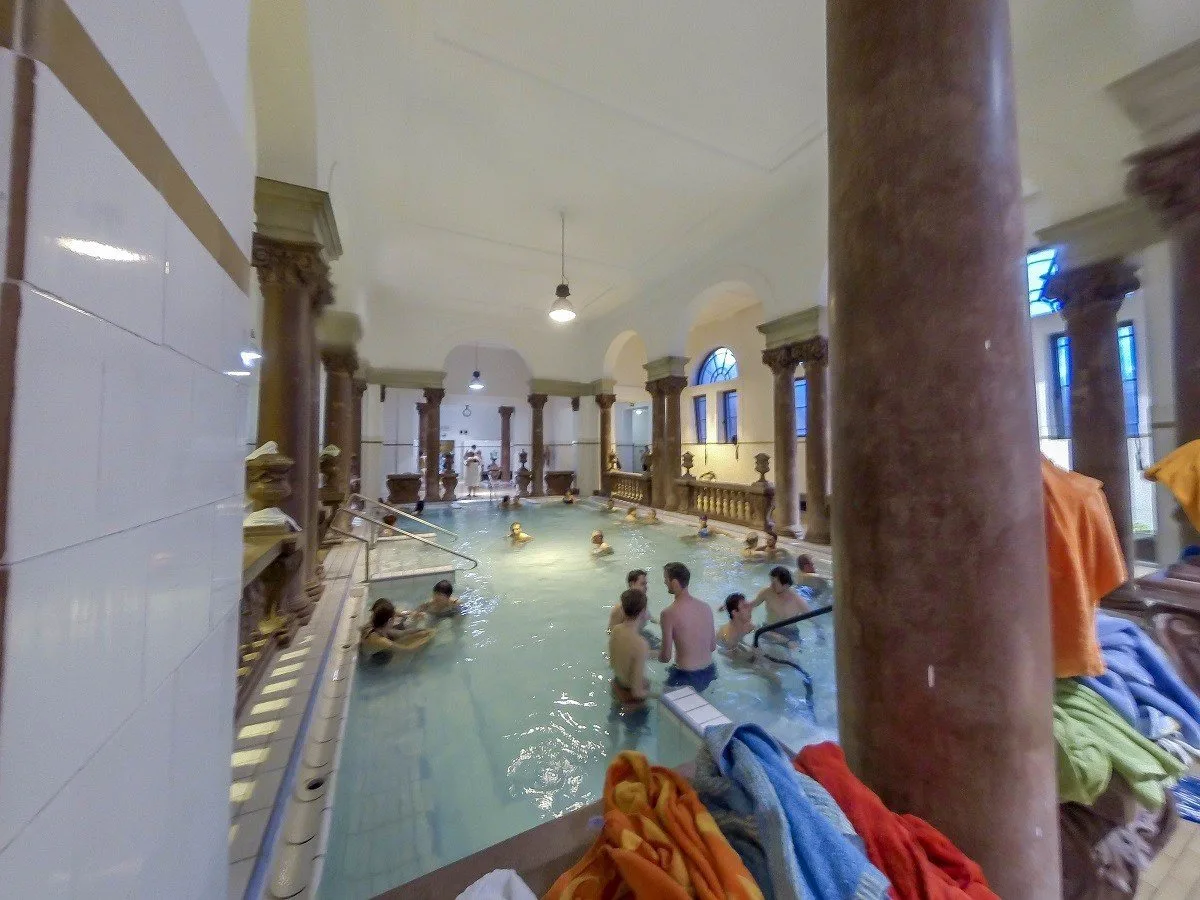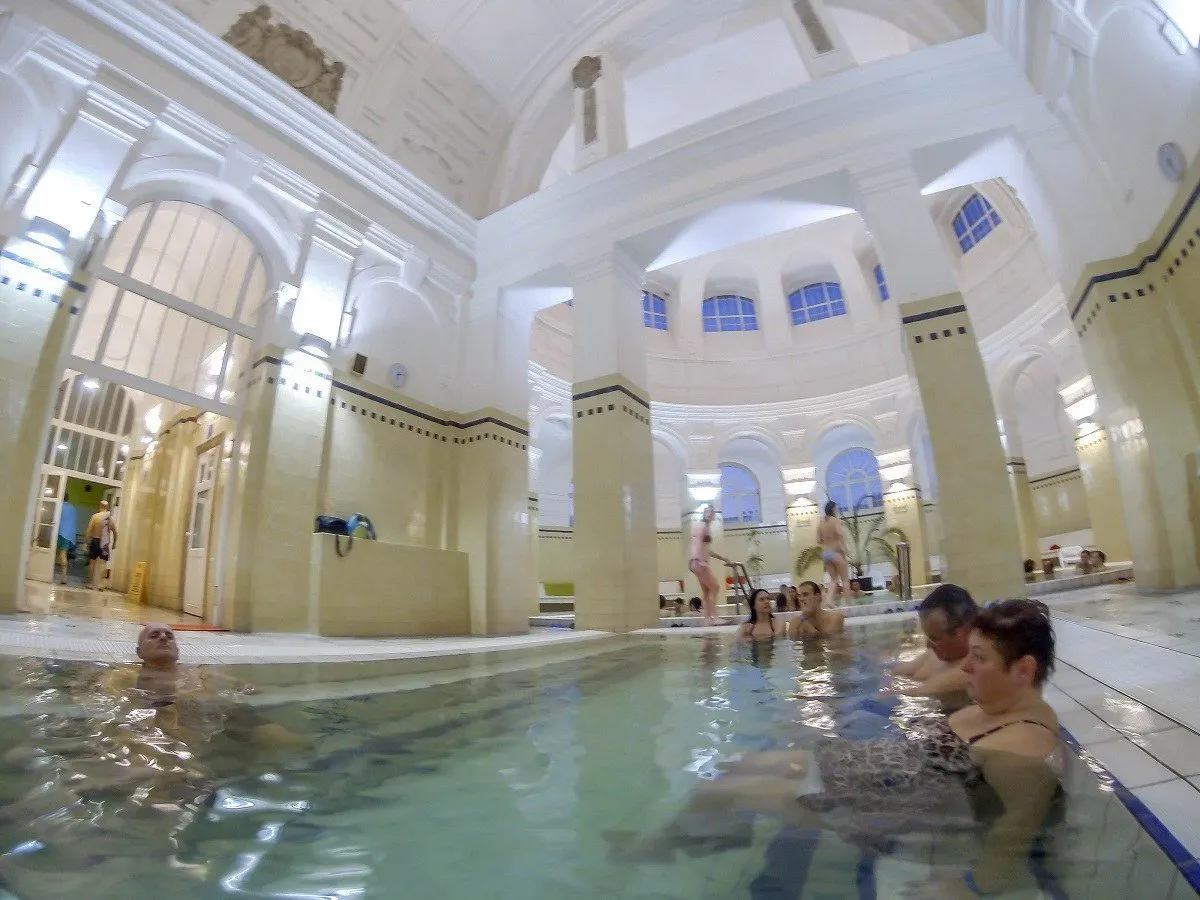The capital of Hungary is The City of Spas. The Budapest thermal baths have been loved by locals and visitors for over two thousand years. During our trips to Budapest, we connected with locals and took a dip into the city’s hot springs. Along with visiting the ruin pubs in Budapest and digging deep into the city’s unique history, visiting the spas is one of our favorite things to do there.
The hot springs along the Danube River in the city of Budapest have been known since at least 100 AD when Romans settled the city of Aquincum (now part of the city). The Roman settlement had warm water public baths. In the 16th century, the hot springs in the region were developed into a spa culture during the Turkish occupation of Hungary. The Turks built large bath complexes and the supporting infrastructure to sustain them.
Today, Budapest is The City of Spas. There are more thermal baths in Budapest than in any other city in the world. There are over 120 hot springs in Budapest feeding over a dozen public bath complexes, plus other private pools in hotel spas.
Each of Budapest’s thermal baths has its own style. Kiraly, Rudas, and Lukacs are all Turkish in aesthetic and feature octagonal pools and lofty dome ceilings. The Gellert Baths have a strong Art Nouveau style that can be seen in many public buildings in Budapest. And the largest spa complex in Europe, the Szechenyi Baths, brings together Greek, Roman, and even Scandinavian architectural elements. Each of the bath complexes has its own style, so of course we needed to explore more than one.
Top Budapest Thermal Baths
Gellert Spa
We loved our visit to the Gellert Spa and its warm pools. While Gellert has some outdoor pools in the summer, it’s recently renovated indoor pools are a must for visitors to Budapest and make Gellert a great place to visit in inclement weather.
The day we visited it was pouring rain and this was a chance to soak in the hot spring waters. We were going to get wet either way, so we decided we might as well enjoy it! Gellert also has the most expensive admission charge, so it caters to a slightly older, more relaxed crowd with fewer children or people looking for a party atmosphere.
Szechenyi Baths
The Szechenyi Thermal Baths, known as one of the best baths in Budapest, offers arguably the most famous image of the city. Every book, brochure, and magazine article about visiting Budapest is sure to include an image of the bright yellow Szechenyi buildings and its outdoor pools (usually with a picture of old men playing chess while having a soak). The image is absolutely iconic. But Szechenyi is much more than a photo–it is an amazing experience in the European bath tradition.
We spent hours wandering from pool to pool searching for the right ambiance and experience. Each pool feels different. Youngsters gather in some, while others cater to older visitors who may have mobility challenges. We easily could have spent the whole day visiting, but only had an afternoon.
Rudas Baths

At the foot of Gellert Hill in Buda, the Rudas Thermal Bath was first built in 1550 during Ottoman rule using the deep underground hot spring waters. Today it maintains key elements of a Turkish bath like its Turkish dome and octagonal pool.
The temperatures of the Rudas baths and swimming pool vary widely from 10 to 42C (50-108F). One of the pools, which we weren’t brave enough to try, actually has an ice dispenser that regularly adds ice every few minutes.
While the therapeutic water inside was lovely, our favorite spot was the rooftop pool. From that vantage point, you can soak with a panoramic view over the Danube River. It’s hard to find a better spot to relax in Budapest.

Palatinus Strand Baths

The Palatinus Strand Baths are located on Margaret Island, a popular park and recreation area in the middle of the Danube. The huge complex features 10 different pools fed by thermal springs outside as well as 4 newly-opened indoor pools that can be visited year-round.
Everywhere we looked, there were kids, parents, and grandparents playing in the fountains, spread out on their towels in the grass, and otherwise just enjoying the beautiful summer day. The big draws at the Palatinus Baths are the wave pool, slides, and fountains. The plentiful fast food stands are also very popular and sell everything from delicious langos to hamburgers at reasonable prices.

We are lovers of hot springs and seek them out on our travels. Some of our favorites have been the Kupele Sklene Teplice in Slovakia, Saturnia in Italy, the Antique Pool in Pamukkale, Turkey, or about any of the hot springs pools in Colorado. But these are some of the nicest we’ve ever visited and we will definitely be back!
Tips for Visiting the Budapest Baths
Here are our top 5 tips for visiting the Budapest baths and hot springs:
Rent a private cabin
Most of the thermal baths in Budapest give you the option of renting a locker (included in the normal price) or renting a private cabin for an additional cost. We believe that renting a private cabin is worth it. If you are at all modest, you’ll appreciate having a private place to change clothes. Even if you have no modesty concerns, the private cabins are worth the cost because they have a lot more space. The lockers are quite small and if you have a backpack or beach bag with you, there is a chance it won’t fit into the locker.
Bring your own towel
While the spas will certainly rent you a towel for a price, you’ll save money and time by bringing your own. The lines to rent towels can be quite long at peak times. Plus, the rental towels all look alike and someone may take yours.
Bring your flip flops or water shoes
Walking around the spa complex, you’ll be walking through pools of standing water along with everyone else. The spas are incredibly clean and hygienic. However, anyone who has ever gotten athlete’s foot will recognize the risk. Just bring your own flip flops and you won’t have a problem. But, be sure to walk carefully, the floors can be very slippery! We use sturdy water shoes (in both mens and womens).
Bring a water bottle
Soaking in the hot water for a period of time can be dehydrating. Water, beverages, and snacks can be available at all the baths in Budapest, but they may not be convenient.
Don’t forget your waterproof camera
If you’re visiting the baths on your vacation, you’ll probably want to take pictures of the experience. So bring that waterproof camera! We took our GoPro, which is better at videos than photos. But I’ve been looking at the Nikon Coolpix, which is good at both.
Visiting Information
Detailed information on the top Budapest thermal baths is below. The baths in Budapest are overseen by a kind of public corporation called BGYH, which produces a magnificent 24-page brochure called Budapest The City of Spas (available for free at any of the spas and in most major hotels). The BGYH website is also helpful for planning.
St. Gellert Thermal Baths and Swimming Pools: Kelenhegyi út 4, 1118 Budapest. Accessible by trams 18, 19, 41, 47 and 49, which let off right in front of the complex. Hours are 06:00-20:00. Gellert features 8 indoor pools, 2 indoor swimming pools and 2 outdoor pools. A day ticket with cabin is HUF 5,700 on weekdays and 5,900 on weekends. Website: www.gellertfurdo.hu
Széchenyi Spa and Swimming Pools: Állatkerti körút 11, 1146 Budapest. Accessible by the 72 trolley or the yellow line metro (this is the M1 Millennium Underground). Hours are 06:00-19:00 for the baths and 06:00-22:00 for the outdoor swimming pools. Szechenyi has 13 indoor thermal pools, 1 outdoor thermal pool, 2 outdoor swimming pools, 2 outdoor immersion pools, plus 3 other indoor pools in the clinic/hospital attached to the complex. A day ticket with cabin is HUF 5,400 on weekdays and 5,600 on weekends. Website: www.szechenyifurdo.hu
Rudas Thermal Baths and Swimming Pool: Döbrentei tér 9, 1113 Budapest. Accessible by trams 18, 19 and 41, along with the 5, 86 and 178 bus lines. Rudas is also a short walk from Gellert. Hours are: 06:00-20:00. There is also co-ed night bathing from 22:00-04:00 on Friday and Saturday nights. Note: the spa is only co-ed on Friday and Saturday. Rudas features 6 thermal pools and one swimming pool. Entrance fees range from HUF 2,000 to 5,900 depending on the day of the week and how many pools you visit. Website: www.rudasfurdo.hu
Palatinus Strand Baths: Margitsziget (Margaret Island), H-1007 Budapest. Accessible by bus line 26. Hours are: 08:00 – 20:00 (slides and adventure elements: 09:00 – 19:30). The entire outdoor complex is open from early June to mid-September and one outdoor pool remains open the rest of the year. Prices range from HUF 2,400 to 3,200 depending on the day and time of year. Website: en.palatinusstrand.hu
Lance Longwell is a travel writer and photographer who has published Travel Addicts since 2008, making it one of the oldest travel blogs. He is a life-long traveler, having visited all 50 of the United States by the time he graduated high school. Lance has continued his adventures by visiting 70 countries on 5 continents – all in search of the world’s perfect sausage. He’s a passionate foodie and enjoys hot springs and cultural oddities. When he’s not traveling (or writing about travel), you’ll find him photographing his hometown of Philadelphia.










Dany
Saturday 13th of August 2016
This is so wonderful, thanks for sharing. I'm going to share on my FB page!